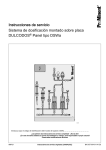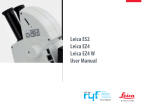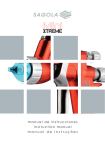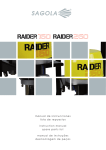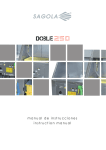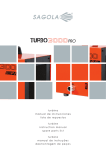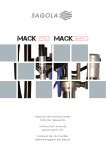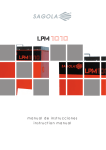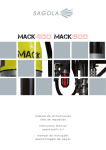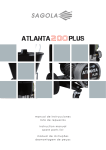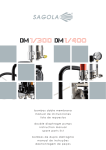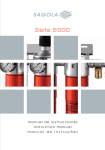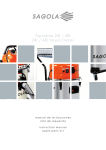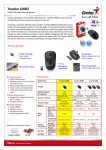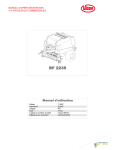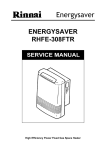Download manual de instrucciones lista de repuestos instruction
Transcript
manual de instrucciones lista de repuestos instruction manual list of spare parts Índice 1 Atención pág. 4 2 Introducción pág. 4 3 Datos Técnicos pág. 4 4 Componentes. Principales partes y zonas pág. 5 5 Principios de funcionamiento pág. 5 6 Advertencias pág. 6 7 Consejos Útiles pág. 6 8 Mandos e indicadores pág. 7 8.1 8.2 8.3 8.4 8.5 8.6 8.7 8.8 pág. 7 pág. 7 pág. 7 pág. 7 pág. 7 pág. 8 pág. 8 pág. 8 9 10 Controlador de temperatura Interruptor general de potencia Piloto indicador “preparado” Sensor de temperatura Flujostato Cámara de aire frío (despresurizada) Cámara de aire caliente (presurizada) Manguera calefactada Preinstalación pág. 8 9.1 9.2 9.3 9.3.1 9.4 pág. 9 pág. 9 pág. 9 pág. 10 pág. 10 Ubicación Conexiones Seguridad Dispositivos de seguridad integrados Otros requisitos Puesta en marcha pág. 11 10.1 10.2 pág. 11 pág. 11 Instalación Programación y ajustes 11 Mantenimiento y reparaciones pág. 12 12 Limpieza pág. 12 13 Seguridad y Salud pág. 13 14 Condiciones de garantía pág. 14 15 Declaración de conformidad pág. 14 - 3 - 1. ATENCIÓN Antes de poner en marcha el equipo, deberá leer, tener en cuenta y cumplir en su totalidad todas las indicaciones descritas en este Manual. Asimismo, deberá tener en cuenta las Normas de Prevención de accidentes, los Reglamentos y Directivas para los Centros de trabajo y las Leyes y restricciones vigentes. Deberá conservarlo en un lugar seguro y accesible a todos los usuarios del equipo. SAGOLA S.A., los logotipos de SAGOLA y otros productos SAGOLA, mencionados en este manual, son marcas registradas o marcas de la empresa SAGOLA S.A. El equipo sólo debe ser puesto en funcionamiento y utilizado por personas instruidas en su manejo, y exclusivamente para ser utilizado para los fines previstos. 2. INTRODUCCIÓN El equipo que tiene en su poder, y dentro de la gama de productos SAGOLA, pertenece a la familia de equipos que se utilizan para proyectar aire comprimido a través de una pistola para pintar o herramienta de aplicación. consulta previa a SAGOLA S.A. Una de sus principales aplicaciones es la de suministrar el aire comprimido utilizado en los procesos de pintado a una temperatura constante e independiente de las condiciones ambientales. El equipo de aire comprimido PACK 6000X AIR HEATER, según los ajustes establecidos “por defecto” es apto para calentar el aire comprimido con cualquier fin industrial. La utilización de este equipo aporta una óptima calidad de acabado manteniendo una temperatura constante en el aire comprimido, tal y como exigen determinados tipos de productos a aplicar. - Con una presión máxima de 7 bar de aire comprimido seco y limpio (en base al tratamiento previo del aire comprimido). Equipo compuesto de serie por: - Calentador de aire. - Manguera de aire calefactada. - Manual de Instrucciones. - Envase. - Con un consumo mínimo de 150 L/min. y un máximo de 750 L/min. - Hasta alcanzar una temperatura máxima de 70oC. Temperaturas mayores, caudales mayores y presiones mayores pueden conseguirse bajo Elementos opcionales y complementarios del equipo: - Manguera de aire anti-estática convencional. - Equipos de Tratamiento del aire comprimido. - Pistolas Aerográficas. 3. DATOS TÉCNICOS Rango de temperaturas nominal Resistencia térmica de los materiales Presion de entrada de aire máxima Caudal de funcionamiento Caudal máximo de aire a 7 bar de presión de entrada Desconexión por defecto Fusible térmico Potencia máxima Fusible por intensidad Peso total estimado Voltaje Frecuencia Dimensiones - 4 - de 20 C a 70 C O 220 C 7 bar 150 L/min. 750 L/min. O a 80 C O 216 C 980 w O 5A 220-240 V 3,6 kg. O 10 A 110-130 V 50-60 Hz Alto:405 mm. Fondo:92 mm. Ancho:255 mm. 4. COMPONENTES. PRINCIPALES PARTES Y ZONAS 1.- Mandos 2.- Interruptor general 3.- Piloto rojo (Calentado) 3.- Piloto verde (Preparado) 4.- Sensor de temperatura 5.- Flujostato 6.- Cámara de aire frío, (despresurizada) 7.- Cámara de aire caliente (presurizada) 8.- Entrada de aire (red) 9.- Salida de aire (manguera) 10.- Conexión eléctrica (manguera calefactada) 6 3 1 3 2 9 8 5 7 4 10 5. PRINCIPIOS DE FUNCIONAMIENTO El aire comprimido frío de la red general de aire se conecta a la entrada del Flujostato (Nº5), que se encarga de detectar el caudal de aire (consumo) necesario para el funcionamiento de la resistencia, y en función del mismo permite o no el encendido de la misma. contenedor del controlador de temperatura PID y los demás componentes eléctricos, entre ellos el Interruptor general (Nº2) y el Piloto luminoso “Preparado” (Nº3). El aire frío entra en la cámara presurizada enfriando el cuerpo del equipo, al mantenerlo aislado de la cámara caliente (Nº7) que contiene la resistencia encargada de calentar el aire. La temperatura deseada de aire caliente en la salida del equipo se determina desde los mandos (Nº1) del controlador de temperatura, al que se accede retirando la tapa de protección. Para conectar el equipo se utiliza el interruptor general (Nº2) El aire sube por la zona central de la Cámara de aire caliente (Nº7), atravesando la propia resistencia, calentádose a la temperatura programada y saliendo por la tubería donde está ubicado el Sensor de temperatura (Nº4) hasta su punto de consumo (pistola o herramienta de aplicación). Una vez realizado el ajuste, montar la tapa de protección. El controlador de temperatura (Proporcional Integral Derivativo) se ocupa de mantener constante la temperatura de salida de aire caliente. La manguera calefactada evita la pérdida del calor del aire. La Cámara de aire frío (sin presión) (Nº6) es el - 5 - 6. ADVERTENCIAS - Antes de la puesta en funcionamiento, y especialmente después de cada limpieza y/o reparación, deberá comprobar que los componentes del equipo esté perfectamente apretados y que las mangueras sean estancas (sin fugas). Las piezas defectuosas deberá cambiarlas o repararlas convenientemente. - Conecte el equipo a una toma eléctrica con conexión a tierra. - La resistencia derivadora total de la línea debe ser <100 millones de ohmios. - Lea y aplique con atención todas los datos, instrucciones y medidas de seguridad indicados por el fabricante de los productos que vaya a utilizar (productos a aplicar, diluyentes, etc.), ya que pueden generar reacciones químicas, incendios y / o explosiones, o ser tóxicos, irritantes o nocivos y en todo caso peligrosos para la salud e integridad del usuario y las personas de su entorno (Ver apartado sobre Salud y Seguridad). - El equipo PACK 6000X AIR HEATER está fabricado conforme a la consecución de la seguridad en su uso. Pese a todo durante la utilización del equipo pueden producirse peligros para el operador o incidencias en la instalación si el equipo se emplea por operario(s) no formado(s) o instruido(s), o no se emplea conforme a lo prescrito. - El régimen típico previsto de trabajo es hasta 70oC. Este régimen de trabajo es orientativo y debe ser corregido en función de la distancia existente entre el equipo y la pistola o herramienta de aplicación (punto de consumo de aire caliente) para compensar las perdidas caloríficas en este tramo. - Utilícelo siguiendo las instrucciones de uso, mantenimiento y seguridad indicadas en el presente manual y realice las prácticas de aplicación necesarias para conseguir la calidad de acabado deseada. - El equipo se suministra despresurizado (sin presión en su interior). - Apague el calentador después de su empleo para reducir el consumo eléctrico y evitar el deterioro acelerado de la manguera calefactada. - Utilice mangueras de aire antiestáticas. EQUIPO DISEÑADO PARA TRABAJAR EN ATMÓSFERAS BIEN VENTILADAS. MANTENER ALEJADO DE CUALQUIER ATMÓSFERA POTENCIALMENTE EXPLOSIVA 7. CONSEJOS ÚTILES - Utilice la más baja presión de pulverización en la boquilla de la pistola o herramienta de aplicación. La que le permita obtener el acabado deseado. No todos los productos necesitan el máximo de presión para ser correctamente pulverizados. Con una presión menor se obtiene un aumento adicional de transferencia de producto. - En el caso de instalar un regulador de presión móntelo siempre previo al PACK 6000X para evitar un posible sobrecalentamiento y dilataciones del regulador. Ajústelo a la presión mínima necesaria para optimizar el funcionamiento del PACK 6000X y ahorrar energía. - Tenga en cuenta que no todas las pinturas aceptan su aplicación con el aire caliente y que éste incluso puede provocar desperfectos en el pintado. - 6 - 8. MANDOS E INDICADORES 8.1. CONTROLADOR DE TEMPERATURA 8.2. INTERRUPTOR GENERAL DE PUESTA EN MARCHA 1.- Muestra el valor de temperatura. Es la captada por el sensor del equipo. (Program value) - Posición 1 “OFF” 2.- Indicador de visualización de la temperatura programada. 3.- Muestra el valor de temperatura programado (nominal). (Set value) Equipo apagado completamente. - Posición 2 “ON” Todos los circuitos activados. 4.- Piloto de autoaprendizaje. Funciona intermitentemente mientras dura el proceso de autoaprendizaje. 8.3 PILOTO INDICADOR “PREPARADO” C1-Se activa cuando hay paso de aire y la resistencia está calentando el aire. Enciende el piloto rojo. Piloto rojo: Calentando 5.- Pilotos de activación de las salidas del controlador. C2-No se utiliza. El piloto “Preparado” (Nº 3) indica al usuario que el equipo está en disposición de trabajar, y con la temperatura de trabajo programada disponible. Piloto verde: Preparado 6.- Piloto indicador de activación de la Alarma 1. 8.4 SENSOR DE TEMPERATURA La Alarma 1 El Sensor de temperatura (Nº 4) está ubicado en la salida del equipo. Se activa cuando la temperatura del equipo alcanza el valor seleccionado, iluminando el piloto “preparado”. El valor de temperatura que activa se determina en el apartado Nº9. 7.- Piloto indicador de activación de la Alarma 2. No se utiliza. 8.5 FLUJOSTATO 8.- Piloto de activación de la Alarma 3. No se utiliza. 9.- Pulsadores para seleccionar la temperatura de trabajo. También utilizados para modificar otros valores, en distintos niveles de programación. 10.- Pulsador “SEL” para confirmar los valores modificados y para acceder a los distintos niveles de programación. 5 7 6 No es indicativo de la temperatura en la pistola o herramienta de aplicación, ya que existirá una pérdida de temperatura por las conexiones, mangueras, etc,... 8 El Flujostato (Nº5) sirve para desactivar eléctricamente la resistencia cuando el consumo de aire comprimido es insuficiente para el correcto funcionamiento del equipo. Por tanto cuando la pistola o herramienta de aplicación no consume aire comprimido, se desactiva la resistencia, activándose en el momento en que se vuelve a tener consumo. Se ajusta en origen a un valor de aproximadamente 150 litros / minuto como caudal mínimo para su funcionamiento. 1 Queda terminantemente prohibido manipular el flujostato sin consulta previa con SAGOLA S.A. LA MANIPULACION DE ESTE COMPONENTE PUEDE PONER EN RIESGO EL BUEN FUNCIONAMINETO DEL EQUIPO 3 4 2 10 9 No hacer caso a esta advertencia puede ocasionar la destrucción de la resistencia y en consecuencia la pérdida de la garantía del equipo. 9 - 7 - Aloja los siguientes elementos: 8.6 CAMARA DE AIRE FRIO, (DESPRESURIZADA) - Resistencia 800W - Fusible térmico tarado a 216oC Aloja los siguientes elementos: - Relé de potencia - Funda de la resistencia para canalizar el aire. - Fusible por intensidad 5A (220-240V) ó 10A (110-130V) 8.8 MANGUERA CALEFACTADA - Piloto “Preparado” Compuesta por: - Controlador de temperatura Manguera especialmente diseñada para evitar pérdidas de calor del aire. - Piloto de activación de la resistencia - Interruptor general - Resistencia flexible 180 w - Manguera anti-estática. 8.7 CAMARA DE AIRE CALIENTE (PRESURIZADA) La cámara se encuentra herméticamente cerrada y presurizada a la presión de la red neumática. 145 Aprox. 9. PREINSTALACIÓN 71 255 Aprox. 71 119.6 6 AGUJEROS MONTAJE EN PARED 49.3 28 n n 6 49.3 405 Aprox. n 34 43.3 n 6 119.6 6 - 8 - 9.1 UBICACIÓN El equipo está configurado para su funcionamiento en posición vertical. 9.2 CONEXIONES 9.2.1. Conexión al calentador La instalación no requiere la utilización de herramientas especiales, basta con realizar adecuadamente las conexiones del equipo a las redes eléctrica y de aire comprimido adecuadamente diseñadas, que previamente deben existir. - A red eléctrica, con enchufe estándar Schuko Bipolar provisto de contacto de tierra lateral de hasta 16 A. de intensidad de corriente AC 220-240V ó 110-130V dependiendo del modelo. - A red de aire comprimido y conexión de 1/4” GAS, capaz de suministrar como mínimo 150l/min. (Demandados por el equipo PACK 6000X Air Heater). 9.2.2. Conexión a la manguera calefactada según figura 1. Fig. 1 9.3 SEGURIDAD La primera vez que utilice su equipo no es necesario realizar el proceso de despresurización, ya que en origen se suministra totalmente despresurizado, pero sí lo será cada vez que realice trabajos de mantenimiento o reparación. El proceso de despresurización consiste en liberar de aire comprimido el equipo, actuando sobre el gatillo de la pistola o herramienta de aplicación hasta verificar que deje de salir aire comprimido. Si no se tiene en cuenta esta instrucción de seguridad, pueden ocurrir averías, lesiones personales y accidentes, pudiendo llegar a ser mortales. SAGOLA S.A. no se responsabiliza de eventuales secuelas debidas a incumplimiento de estas normas de seguridad. Realice el ajuste y la preparación del equipo con mucha atención. Tenga especial cuidado con la programación avanzada ya que un error puede ocasionar un mal funcionamiento del equipo y, ocasionalmente, destruir los fusibles de protección o provocar sobrecalentamiento y rotura de la resistencia. Preste mucha atención cuando realice trabajos de mantenimiento y reparación. Antes de utilizar el equipo, y por parte de su propietario, deben verificarse las siguientes medidas de seguridad: - Que no se permita el acceso al equipo de personas sin una formación adecuada en los aspectos de seguridad, manejo y funcionamiento del equipo. - Que se asegure que el operario destinado a utilizar el equipo tenga los conocimientos básicos de manejo del equipo, protección del medio ambiente y que haya leído, asimilado y tenga a su disposición el manual de instrucciones del equipo. En caso de duda consulte al S.A.T. de SAGOLA. - Que la persona destinada a programar, desmontar y realizar las tareas de mantenimiento y reparación del equipo tenga conocimientos suficientes de electricidad, mecánica y neumática. Conozca(n) la construcción y el principio de funcionamiento del equipo, las normas de seguridad y las normas de gestión de residuos industriales y que haya sido autorizado por el S.A.T. de SAGOLA. - Que el equipo esté ubicado fuera de la zona de trabajo (alejado de potenciales ambientes con atmósferas explosivas) y preferentemente al alcance de la vista del operario, para que pueda consultar el encendido del piloto “Preparado”. - Que el equipo esté bien fijado a la pared y que las conexiones neumáticas y eléctricas estén en perfecto estado. Sin fugas de aire ni daños en los cables eléctricos. - Que el valor de temperatura programado esté dentro de los límites permitidos (hasta 70º C). - Que en el caso de que se desee trabajar con un valor de temperatura programado por encima de 50ºC deben utilizarse medidas de protección (aislantes térmicos), adecuadas para el manejo de las piezas y herramientas que pueden entrar en contacto con el aire caliente. Especialmente el racor de salida de aire caliente del equipo, la pistola o herramienta de aplicación y las mangueras (tuberías). - 9 - 9.3.1 Dispositivos de seguridad integrados apague el equipo y revise su estado. Fusible térmico Protección de los mandos El equipo está provisto de un fusible térmico de 216ºC ubicado en la cámara de aire caliente (Nº 8). Este fusible protege el equipo contra sobrecalentamientos ocasionados por un mal funcionamiento o programación indebida del controlador. Está destinado a cortar la alimentación eléctrica a la resistencia al alcanzar la temperatura límite. El equipo está provisto de una tapa protectora con cristal transparente que cubre por completo todos los mandos del controlador de temperatura, protegiéndolos de polvo, vapores y derrames ocasionales de líquidos. Al mismo tiempo protege de una programación errónea por accionamiento involuntario sobre las teclas del controlador de temperatura. Después de haberse producido inutilización al alcanzar la temperatura de 216ºC debe sustituirse. Consulte con el Servicio de asistencia técnica (SAT) de SAGOLA S.A. Fusible por intensidad El equipo está provisto de un fusible por aumento de la intensidad, que protege todo el equipo en el caso de que haya un consumo elevado por encima de 5A (220-240V) o 10A (110-130V), (cortocircuito o fallo de la resistencia). Después de haberse producido su inutilización al alcanzar la intensidad de 5 A o 10 A debe sustituirse. Consulte con el Servicio de asistencia técnica (SAT) de SAGOLA S.A. Desconexión por falta de circulación de aire El equipo está provisto de un flujostato que protege la resistencia de sobrecalentamientos, en ausencia de consumo de aire frío y posterior refrigeración insuficiente de la resistencia. Asegura el ahorro de energía cuando no hay consumo de aire y le protege frente a una puesta en marcha indebida (por error) del equipo. El punto de disparo del flujostato está ajustado a un valor de 150 l/min. Si existen sospechas de fallos de funcionamiento del flujostato, Consulte con el Servicio de asistencia técnica (SAT) de SAGOLA S.A. Aislantes térmicos al exterior “Toque frío” El diseño y la construcción del equipo, así como los aislantes térmicos utilizados, aseguran que las superficies exteriores del equipo se mantienen frías durante su funcionamiento, exceptuando el racor de salida de aire comprimido que se mantendrá caliente. Cuando realice la programación del equipo, para evitar roturas, deterioros o extravío, recomendamos colocar la tapa protectora sobre la chapa de amarre del PACK 6000X AIR HEATER, en el pliegue previsto para tal fin. 9.4 OTROS REQUISITOS - El equipo debe estar protegido contra vertidos o proyecciones de líquidos. - Debe existir ventilación suficiente. - El uso previsto del equipo presupone que todas las piezas del equipo han de estar montadas, en condiciones de trabajo adecuadas y no presentar deformaciones o roturas. - El uso del equipo debe efectuarse con un suministro de aire comprimido y eléctrico activado, estable y acorde con las especificaciones técnicas establecidas. - A un uso conforme a lo prescrito, también pertenece el cumplimiento de las indicaciones contenidas en el manual de instrucciones, y especialmente las de la seguridad, operativo y control, descritas en este manual. - Antes de cada puesta en marcha y especialmente después eventuales reparaciones, deberá comprobar que todos los elementos estén perfectamente apretados. La temperatura de las superficies exteriores del equipo en ningún caso debe sobrepasar la temperatura seleccionada en el controlador de temperatura. En el caso de detectar un calentamiento excesivo de las superficies exteriores del equipo - 10 - 10. PUESTA EN MARCHA 10.1 INSTALACIÓN do del piloto “Preparado”, cuando se realicen paradas con corte de consumo de aire. - Posiciónelo en su ubicación. - Preste especial atención al piloto “Preparado” y no trabaje cuando el piloto “Preparado” esté apagado. - Desembale el equipo. - Fije el equipo a la pared. - Conéctelo a la red de aire comprimido, límpio y prefiltrado. - Asegúrese de que el interruptor general (Nº 2) está en posición “OFF”. Para trabajar con una temperatura más uniforme se recomienda que no realice paradas largas (superiores a 2 min.) durante el trabajo. 10.2 PROGRAMACION Y AJUSTES - Conecte la manguera calefactada. - Conecte el equipo a la red eléctrica. - Mueva el interruptor a la posición “ON” y compruebe que el piloto de activación de la resistencia no se enciende. - Por medio de los pulsadores en el controlador de temperatura (Nº1) ajuste la temperatura de trabajo entre 30-40oC. - Espere entre 3 y 5 minutos, dependiendo de las condiciones ambientales para calentar la manguera. - Inicie el trabajo. Verifique el encendido y apaga- El valor de temperatura deseado se programa por medio de los pulsadores en el controlador de temperatura de la siguiente manera: - Modifique el valor de temperatura deseado por medio de los pulsadores. Para asegurar una correcta programación de la temperatura, ésta debe ser superior a la temperatura ambiente. El equipo está configurado para trabajar a una temperatura máxima de 80oC. - 11 - 11. MANTENIMIENTO Y REPARACIONES Antes de iniciar el trabajo, verificar el estado de las mangueras de producto, así como las conexiones de los elementos por los que fluye el producto. Para efectuar el mantenimiento o una reparación, desconecte previamente el equipo de las redes de aire comprimido y eléctrica y despresurícelo. Los trabajos de mantenimiento y reparación del equipo solo deben ser realizados por personal autorizado por SAGOLA, S.A. El equipo por su propia construcción y diseño no requiere ningún mantenimiento periódico. También se precisa un especialista cualificado para modificar los ajustes “por defecto” de fábrica, cuando así se requiere. Es obligatorio el uso de los guantes térmicos resistentes hasta 200oC para el manejo del equipo, aunque trabaje con temperaturas inferiores, para asegurar la salud y seguridad del operario en el caso de un eventual fallo del sensor de temperatura. PARA TODOS ESTOS CASOS RECOMENDAMOS LA INTERVENCIÓN DEL SERVICIO DE ASISTENCIA TÉCNICA (SAT) DE SAGOLA S.A. SAGOLA S.A. se reserva el derecho de no autorizar la realización de determinados trabajos en el equipo. Es imprescindible hacer una revisión periódica del equipo para verificar el estado de sus componentes y sustituirlos cuando no estén en perfectas condiciones. PARA OBTENER EL MEJOR RESULTADO POSIBLE UTILICE SIEMPRE REPUESTOS ORIGINALES SAGOLA. 12. LIMPIEZA Limpie periódicamente el equipo, especialmente los pilotos indicadores y la tapa protectora de los mandos de control. Mantengalos suficientemente visibles. Mantenga limpias de elementos extraños las zonas de cierre de paso de aire. No utilice objetos duros o punzantes. - 12 - 13. SEGURIDAD Y SALUD Para efectuar el mantenimiento, una reparación o limpieza, desconecte previamente el equipo de la red eléctrica y neumática, después de haber realizado correctamente el proceso de DESPRESURIZACION. Los locales deben estar dotados de ventilación suficiente y acorde con las normativas y disposiciones vigentes al respecto. En el entorno del equipo sólo debe existir la cantidad de producto y diluyente necesarios para el trabajo que se está realizando. Después de finalizar el mismo deberá retornar los diluyentes y productos a aplicar, a su lugar específico de almacenamiento. Mantener la zona de trabajo limpia y exenta de desechos potencialmente peligrosos (Diluyentes, trapos, etc...) Durante el trabajo y en la zona de trabajo, no debe existir ninguna fuente de ignición (fuego abierto, cigarrillos encendidos, etc.), ya que durante el mismo se pueden generar gases fácilmente inflamables. Asimismo deberá utilizar la protección laboral homologada (respiratoria, auditiva, etc.) de acuerdo con las Normativas establecidas al respecto. Si el equipo se utiliza de forma inadecuada o se alteran sus componentes, pueden aparecer daños materiales y provocar graves secuelas físicas en el propio cuerpo, en personas ajenas y/o animales, pudiendo llegar incluso la muerte. SAGOLA, S.A. no se responsabiliza de estos daños producidos por el mal uso del equipo. Utilice siempre equipos respiratorios homologados conforme a las Normativas y Reglamentos vigentes para protegerse de las emanaciones producidas en la aplicación. No supere nunca la presión máxima de trabajo. Los equipos están tarados por el fabricante de acuerdo con las prestaciones de diseño descritas en sus características. Como medida preventiva general se aconseja que utilice gafas protectoras, de acuerdo con las normativas y características ambientales específicas del Centro de trabajo y las Normativas vigentes. Utilice guantes al manipular el producto (ver recomendaciones del fabricante) y al limpiar la pistola. Si durante la utilización del equipo el nivel sonoro ambiental sobrepasa 90 dB. es recomendable el uso de protectores acústicos homologados.La pistola en sí misma no propicia ningún riesgo mecánico de perforaciones, impactos o pinzamientos, salvo los derivables de instalaciones indebidas o manipulaciones incorrectas. UTILICE MANGUERAS ANTIESTÁTICAS SAGOLA PARA ELIMINAR LAS POSIBLES DESCARGAS ELÉCTRICAS QUE PUDIERAN CREAR RIESGOS DE INCENDIO O EXPLOSIÓN. La manipulación del equipo, requiere una atención adecuada, para evitar que se produzcan en el mismo deterioros generadores de situaciones de peligro para el usuario o las personas que se hallen próximas, como consecuencia de escapes, roturas, etc. La utilización de disolventes y/o detergentes que contengan hidrocarburos halogenados (Tricloretano, Cloruro de metilo, etc.), puede originar reacciones químicas en el equipo, así como en sus componentes cincados (el tricloroetano mezclado con pequeñas cantidades de agua produce ácido clorhídrico). Debido a ello, tales componentes pueden oxidarse y en caso extremos, la reacción química originada puede efectuarse de forma explosiva. Recomendamos que utilicen productos que no contengan los componentes mencionados. En ningún caso se deben utilizar ácidos, sosa (álcalis, o decapantes, etc.) para su limpieza. En general, toda manipulación del equipo debe realizarse teniendo la precaución de no deteriorarlo. Los racores de unión deben estar bien apretados y en buen estado de uso. Las normas de seguridad deben estar comprendidas y aplicadas. El incumplimiento de las indicaciones del presente manual puede ocasionar incidentes que pueden repercutir en la integridad física del usuario u otras personas o animales. Respete y cumpla las indicaciones relativas a la preservación del medio ambiente. - 13 - 14. CONDICIONES DE GARANTÍA Este aparato ha sido fabricado con rigurosa precisión, habiendo sido sometido a numerosos controles antes de su salida de fábrica. Esta GARANTÍA no respalda los compromisos adquiridos con cualquier persona ajena a nuestro Servicio Técnico. La GARANTÍA concedida es de 3 años, a partir de la fecha de compra, que será indicada por el establecimiento vendedor en el lugar habilitado al respecto, junto con su sello. En caso de avería durante el periodo de garantía, adjunte al aparato el certificado de garantía debidamente cumplimentado, y entréguelo en el Servicio de Asistencia que más le interese, o bien poniéndose en contacto con fábrica. Una vez recepcionado el equipo, cumplimente la garantía y remítala al fabricante para su validación. Esta GARANTÍA cubre cualquier defecto de fabricación, que será subsanado sin cargo para el comprador. Sin embargo quedan expresamente excluidas todas aquellas averías resultantes de un mal uso del equipo, tales como conexiones incorrectas, rotura por caídas ó similares, desgaste normal de componentes y en general cualquier deficiencia no imputable a la fabricación del aparato. Asimismo se perderá la GARANTÍA cuando se constate que el aparato ha sido manipulado por personas ajenas a nuestro Servicio de Asistencia Técnica. Queda excluida cualquier exigencia de más trascendencia contra el proveedor, en particular la indemnización por daños y perjuicios. Esto se aplica igualmente a los daños que se originasen durante el asesoramiento, la adquisición de practica y la demostración. Las prestaciones por garantía no tienen por consecuencia una prolongación del periodo de la misma. No se atenderá en garantía ningún aparato del cual no conste en los archivos de SAGOLA S.A. el resguardo adjunto, del certificado de garantía debidamente cumplimentado. Reservadas las modificaciones Técnicas. 15. DECLARACIÓN DE CONFORMIDAD CE PARA MÁQUINAS Según la directiva 89/392/CE, Anexo II, Apartado A, de fecha 14 de junio de 1989 Fabricante: SAGOLA S.A. Dirección: Calle Urartea, 6 · 01010 VITORIA-GASTEIZ (Álava) ·ESPAÑA Declaramos que el producto: Marca: SAGOLA Modelo: PACK 6000X Air Heater Es conforme con las disposiciones de las Normas 2006/95 CE, 2006/42 CS y 2004/108 CE Se encuentran disponibles, la documentación técnica completa y las instrucciones de servicio del producto en la versión original, así como en los idiomas comunitarios de los usuarios. En Vitoria-Gasteiz, a 01/07/2011 Firma: Director general - 14 - Index 1 Attention page 16 2 Introduction page 16 3 Technical Data page 16 4 Components. Main parts and areas page 17 5 Operating principles page 17 6 Warnings page 18 7 Useful Tips page 18 8 Controls and indicators page 19 8.1 8.2 8.3 8.4 8.5 8.6 8.7 8.8 page 19 page 19 page 19 page 19 page 19 page 20 page 20 page 20 9 10 Temperature controller Main power switch “Ready” pilot light Temperature sensor Flow meter Cold air chamber (despressrised) Hot air chamber (pressurised) Heated hose Preinstallation page 20 9.1 9.2 9.3 9.3.1 9.4 page 21 page 21 page 21 page 22 page 22 Location Connections Safety Integrated safety devices Other requirements Starting up page 23 10.1 10.2 page 23 page 23 Installation Programming and adjustments 11 Maintenance and repairs page 24 12 Cleaning page 24 13 Safety and Health page 25 14 Guarantee conditions page 26 15 Declaration of conformity page 26 - 15 - 1. ATTENTION Before starting up the equipment, please read, take into account and follow all the recommendations described in this manual. Keep it in a safe place that is accessible to all the users of the equipment. The equipment must only be started up and used by personnel instructed in its operation and it must exclusively be used for the intended purposes. Similarly, the Accident prevention Standards, the Workplace Regulations and Directives and the current laws and restrictions, must be taken into account. SAGOLA S.A., the SAGOLA logos and other SAGOLA products mentioned in this manual are registered trademarks or brand names of the SAGOLA S.A. company. 2. INTRODUCTION The equipment you have purchased and within the SAGOLA product range, belongs to the family of equipment used to project compressed air through a spray gun or as an application tool. One of its main applications is to supply the compressed air used in painting processes at a constant temperature, regardless of the environmental conditions. The PACK 6000X AIR HEATER compressed air equipment, in accordance with the set “default” settings is suited for heating compressed air for any industrial application. The use of this equipment provides an optimal surface quality finish, whilst maintaining a constant temperature in the compressed air, as required for the application of certain types of products. With a maximum pressure of 7 bar of compressed dry and clean air (based on the prior treatment of the compressed air). Factory line equipment comprised of: - Air heater. - Heated air hose. - Instruction manual. - Packaging. With a minimum consumption of 150 L/min. and a maximum of 750 L/min. Until it reaches a maximum temperature of 70ºC. Higher temperatures, greater flow rates and higher pressures can be attained following prior consultation to SAGOLA S.A. Optional and supplementary components of the equipment: - Conventional anti-static air hose. - Compressed air treatment equipment. - Spray guns. 3. TECHNICAL DATA Nominal temperature range Heat resistance of the air pressure Input materials at the maximum Operating flow throughput Maximum air flow at an air input pressure of 7 bar Disconnection by default Thermal fuse Maximum power Power intensity fuse Total estimated weight Voltage Frequency Dimensions - 16 - de 20 C to 70 C O 220 C 7 bar 150 L/min. 750 L/min. O at 80 C O 216 C 980 w 5A 10 A 3.6 kg. 220-240 V 110-130 V 50-60 Hz Height:405 mm. Depth:92 mm. Width:255 mm. O O 4. COMPONENTS. MAIN PARTS AND AREAS 1.- Controls 2.- Main switch 3.- Red led (Heating) 3.- Green led (Ready) 4.- Temperature sensor 5.- Flow meter 6.- Cold air chamber, (depressurised) 7.- Hot air chamber, (pressurised) 8.- Air inlet (network) 9.- Air outlet (hose) 10.- Electrical connection (heated hose) 6 3 1 3 2 9 8 5 7 4 10 5. OPERATING PRINCIPLES The compressed cold air of the general air network is connected to the input of the flow stabiliser (No.5), which monitors the air flow (intake) required for the operation of the resistance and based on it to allow it or not to be turned on. The cold air enters the pressurised chamber cooling the shell of the equipment, in keeping it isolated from the hot chamber (No.7) that contains the resistance used for heating the air. The air rises up through the central part of the hot air chamber (No.7), going through the resistance and is then heated to the programmed temperature and is piped out where the temperature sensor is located (No.4) to its point of consumption (spray gun or application tool). The cold air chamber (without pressure) (No.6) is the container for the PID temperature controller and the other electrical components, including the Main switch (No.2) and the “Ready” pilot light (No.3). The to connect the equipment main switch (No.2) is used. The desired temperature of hot air at the outlet of the equipment is determined using the controls (No.1) of the temperature controller, which can be accessed by removing the protective cover. Once the adjustment has been made, refit the protective cover. The temperature controller (Proportional Integral Derivative) ensures that the output hot air temperature is maintained constant. The heated hose prevents heat loss of the air. - 17 - 6. WARNINGS - Before the putting into operation and especially after each cleaning and/or repair process, check that the components of the equipment are perfectly tight and that the hoses are sealed (without leaks). You must replace or properly repair defective parts. - The PACK 6000X AIR HEATER equipment is manufactured to achieve safety in use. Nevertheless during the use of the equipment hazards for the operator or incidents may occur in the installation if the equipment is used by operators that are not properly trained or instructed or it is not used in accordance with the recommendations. - Use it according to the usage, maintenance and safety instructions in this manual and do the practice applications required to achieve the desired finish quality. - The equipment is supplied depressurised (without pressure inside). - Connect the equipment to a grounded electrical outlet. - The total shunt resistance of the line must be <100 million ohms. - Carefully read and apply all the information, instructions and safety measures indicated by the manufacturer of the products to be used (products to be applied, solvents, etc.), as these may cause chemical reactions, fires and/or explosions or be toxic, irritant or noxious and in any event hazardous for the health and integrity of the user and people around him (See section on Health and Safety). - The typical expected working regime is of up to 70ºC. This working regime is merely a guideline and must be corrected according to the distance between the equipment and the spray gun or application tool (hot air consumption point) to compensate for heat losses in this stretch. - Switch off the heater after use to reduce electricity consumption and prevent the accelerated deterioration of the heated hose. - Use anti-static air hoses. EQUIPMENT DESIGNED TO BE OPERATED IN WELL VENTILATED ENVIRONMENTS. KEEP WELL AWAY FROM ANY POTENTIALLY EXPLOSIVE ATMOSPHERE 7. USEFUL TIPS - Use the lowest spray pressure in the nozzle of the spray gun or application tool. That which allows you to obtain the desired finish. Not all products require the maximum pressure to be properly sprayed. With a lower pressure one will obtain an additional increase in product transfer. - If you install a pressure regulator always mount it before the PACK 6000X to avoid possible overheating and dilation of the regulator. Set it to the minimum pressure required to optimise the performance of the PACK 6000X and save energy. - Please note that not all types of paint can be applied with hot air and that this may even cause imperfections in the paint finish. - 18 - 8. CONTROLS AND INDICATORS 8.1. TEMPERATURE CONTROLLER 8.2. GENERAL START UP SWITCH 1.- Displays the temperature value. Is that captured by the sensor on the equipment. (Program value) - Position 1 “OFF” 3.- Displays the value of the programmed temperature (nominal). (Set value) All circuits activated. 2.- Temperature display indicator programmed. 4.- Self-tutoring pilot light. Blinks intermittently during the self-tutoring process. 5.- Pilot lights indicating the activation of the outputs of the controller. C1-Is activated when there is air flow and the resistance is heating the air. Turn on the red light. C2-Not used. Equipment completely switched off. - Position 2 “ON” 8.3 “READY” PILOT LIGHT The “Ready” (No.3) pilot light shows the user that the equipment is ready to operate and at the programmed working temperature. Red led: Heating Green led: Ready 6.- Pilot light indicating activation of Alarm 1. Alarm 1 It’s activated when the temperature of the equipment reaches the set valve, iluminating the pilot “Ready”. The temperature valve active is determined in No.9 section. 8.4 TEMPERATURE SENSOR Temperature sensor (No, 4) is located at the outlet of the equipment. 7.- Pilot light indicating activation of Alarm 2. It is not indicative of the temperature in the spray gun or application tool, as there will be a loss of temperature due to connections, hoses, etc... 8.- Pilot light indicating activation of Alarm 3. 8.5 FLOW METER 9.- Push buttons to select the working temperature. Also used to modify other values, at different program levels. The flow meter (No. 5) is used to electrically disable the resistance when the compressed air consumption is insufficient for the proper operation of the equipment. Therefore, when the spray gun or application tool does not consume compressed air, the resistance is disabled, once again becoming enabled when consumption is resumed. Not used. Not used. 10.- “SEL” push button to confirm the modified values and access the different programming levels. 5 7 6 It is set at the factory to a value of approximately 150 litres / minute as the minimum flow for its operation. 8 1 It is strictly forbidden to manipulate the flow switch without prior consultation with SAGOLA S.A. LA MANIPULATION OF THIS COMPONENT MAY PUT THE PROPER OPERATION OF THE EQUIPMENT AT RISK 3 Ignoring this warning may lead to the destruction of the resistance and thus the voiding of the guarantee that covers the equipment. 4 2 10 9 9 - 19 - 8.6 COLD AIR CHAMBER, (DEPRESSURISED) Contains the following components: Contains the following components: - Thermal fuse set to 216oC - 800W resistance - Cover of the resistance for channelling the air. - Power relay - Temperature controller - 5A fuse (220-240V) or 10A (110-130V) 8.8 HEATED HOSE - “Ready” pilot light Hose specially designed to avoid loss of heat from the air. - Resistance activation pilot light Comprised of: - Main switch - Flexible 180 w resistance. - Anti-static hose. 8.7 HOT AIR CHAMBER, (PRESSURISED) The chamber is hermetically closed and pressurised at the pressure of the pneumatic grid. 145 Approx. 9. PREINSTALLATION 71 255 Approx. 71 119.6 6 WALL MOUNT HOLES 49.3 28 n n 6 - 20 - 6 49.3 405 Approx. n 34 43.3 n 6 119.6 9.1 LOCATION The equipment is configured to be operated its vertical position. 9.2 CONNECTIONS 9.2.1. Connecting the heater The installation does not require the use of special tools, it is merely enough to properly connect the equipment to the mains power supply and that of a properly designed compressed air grid, which must previously exist. - To the mains, with a standard Schuko Bipolar plug fitted with a lateral grounding contact for up to 16 A with a current intensity of 220-240V or 110-130V AC depending on the model. - To the compressed air grid and the connection to 14” GAS, capable of supplying at least 150l/min. (Required by the PACK 6000X Air Heater equipment). Take the utmost care when adjusting and preparing the equipment. Take special care with advanced programming, as an error may cause the equipment to malfunction and occasionally destroy the protection fuses or cause the resistance to overheat and break. Pay close attention when performing maintenance and repair tasks. Before using the equipment and by its owner, the following safety measures must be verified: - Do not allowing access to the equipment of people without proper training in the aspects of safety, handling and operation of the equipment. - Ascertain that the operator who is to use the equipment has the basic knowledge of the operation of the equipment, the protection of the environment and that he has read, understood and has at his disposal the instruction manual of the equipment. If in doubt, please contact SAGOLA's Technical Assistance Service. - That the person intended to program, dismantle and perform maintenance tasks and repair the equipment has adequate knowledge of the electrical, mechanical and pneumatic aspects. Get to know the build and the operating principle equipment, the safety standards and industrial waste management norms and that have been approved SAGOLA's Technical Assistance Service. 9.2.2. Heated hose connection according to figure 1. - That the equipment is located outside the working area (away from potential environments with potentially explosive atmospheres) and preferably within the operator's sight, so that he can check that the “Ready” pilot light is on. Figure 1 9.3 SAFETY The first time you use your computer it is not necessary to perform the depressurisation process, as it is supplied fully depressurised but it will be whenever maintenance or repair work is carried out. The depressurisation process consists of releasing the compressed air equipment, acting on the trigger of the spray gun or application tool until it is ascertained that compressed air ceases to flow out. If one does not take this safety instruction into account, breakdowns, personal injuries and accidents may occur, which can be deadly. SAGOLA S.A. shall have no liability for any sequels due to the breach of these safety norms. - That the equipment is properly fastened to the wall and that the pneumatic and electrical connections are in perfect condition. Without air leaks or damage to the electrical cables. - That the programmed temperature value is within the allowed limits (up to 70°C). - That in the event that one wishes to work with a value of temperature programmed above 50°C one must use the appropriate protective measures (heat insulation), for the handling of the parts and tools that may come into contact with the hot air. Especially the coupling of the hot air outlet of the equipment, the spray gun or the application tool and the hoses (pipes). - 21 - 9.3.1 Integrated safety devices Protection of the controls Thermal fuse The equipment is fitted with a protective cover with transparent glass that completely covers all the temperature controller's controls, protecting these from dust, vapours and occasional spills of liquids. At the same time it protects against erroneous programming by the unintentional pressing of the temperature controller keys. The equipment is fitted with a 216ºC thermal fuse, located in the hot air chamber (No.8). This fuse protects the equipment against overheating caused by a malfunction or wrong programming of the controller. It is intended to cut the power to the resistance when the temperature limit is reached. After it having been rendered inactive by reaching a temperature of 216ºC it must be replaced. Please contact SAGOLA's Technical Assistance Service (TAS). Intensity fuse The equipment is fitted with an intensity spike fuse, which protects all the equipment in the event of high consumption above 5A (220-240V) or 10A (110-130V), (short-circuit or malfunction of the resistance). After it having been rendered inactive by reaching an intensity of 5A or 10A it must be replaced. Please contact SAGOLA's Technical Assistance Service (TAS). Disconnection due to lack of air circulation The equipment team is fitted with a flow meter, which protects the resistance from overheating, in the absence of cold air consumption and subsequent insufficient cooling of the resistance. It ensures energy savings when there is no air consumption and protects it against undue starting up (by error) of the equipment. The trigger point of the flow meter is set to a value of 150 L/min. If malfunction of the operation of the flow meter is suspected, please contact SAGOLA's Technical Assistance Service (TAS). When programming the equipment, to prevent breakage, damage or loss, we recommend that you fit the protective cover on the anchoring plate of the PACK 6000X AIR HEATER, in the groove provided for this purpose. 9.4 OTHER REQUIREMENTS - The equipment must be protected against the spill or the projections of liquids. - There must be sufficient ventilation. - The intended use of the equipment requires that all parts of the equipment must be assembled, in adequate working conditions and do not display deformities or breakage. - The equipment must be used with an electrical and compressed air supply that is activated, stable and in accordance with established technical specifications. - For use according to that prescribed, one must also comply with the indications contained in the instruction manual and especially those on safety, operation and control described in this manual. - Before each start up and especially after any repairs, one must check that all the components are perfectly tightened. “Cold touch” heat insulation to the outside The design and construction of the equipment, as well as the thermal insulation used, ensure that the outer surfaces of the equipment are kept cold during operation, with the exception of the compressed air coupling, which will be kept hot. The temperature of the outer surfaces of the equipment shall in any event not exceed the temperature selected on the temperature controller. If excessive heating of the outside surfaces of the equipment is detected, turn off the equipment and check its condition. - 22 - 10. STARTING UP 10.1 INSTALLATION - Start working. Check that the “Ready” pilot light turns on and off when stops are made with a cut-off in air consumption. - Unpacking the equipment. - Position it in its location. - Pay special attention to the “Ready” pilot light and do not work when the “Ready” pilot light is off. - Attach the equipment to the wall. - Connect it to the clean and prefiltered compressed air grid. - Ensure that the main switch (No.2) is in the “OFF” position. - Connect the heated hose. - Connect the equipment to the mains power supply. - Move the switch to the “ON” position and check that the resistance activation pilot light does not come on. - By means of the buttons on the temperature controller (No.1) set the working temperature between 30-40ºC. - Wait between 3 and 5 minutes, depending on the environmental conditions to heat the hose To work with a more even temperature it is recommended to not make stops long (more than 2 minutes) during the work. 10.2 PROGRAMMING AND ADJUSTMENTS The desired temperature value is programmed by means of the push buttons on the temperature controller as follows: - Modify the value of the desired temperature by means of the push buttons. To ensure proper programming of the temperature, this must be higher than the ambient temperature. The equipment is configured to operate at a maximum temperature of 80ºC. - 23 - 11. MAINTENANCE AND REPAIRS Before starting work, check the condition of the product hoses, as well as the connections of the components through which the product flows. to ensure the health and safety of the operator in the event of an eventual malfunction of the temperature sensor. To perform maintenance or repair work, previously disconnect the equipment from the compressed air grid and the mains and depressurise it. FOR ALL THESE CASES WE RECOMMEND THE INTERVENTION OF SAGOLA S.A.'s TECHNICAL ASSISTANCE SERVICE (TAS) Maintenance and repair tasks on the equipment may only be done by personnel authorised by SAGOLA, S.A. SAGOLA S.A. reserves itself the right to not authorise the performance of certain tasks on the equipment. Due to its construction and design the equipment does not require any regular maintenance. It is essential to perform a regular review of the equipment to verify the condition of its components and replace these when they are not in perfect condition. A qualified specialist is also required to change the factory “default” settings, when so required. Is it compulsory to use gloves that are heat resistant to 200ºC for handling the equipment, even though you may work at lower temperatures, TO OBTAIN THE BEST POSSIBLE RESULTS ALWAYS USE ORIGINAL SAGOLA SPARE PARTS. 12. CLEANING Regularly clean the equipment, especially the pilot lights and the protective cover of the control keys. Keep them sufficiently visible. Keep free of foreign objects the air passage closure areas. Do not use hard or sharp objects. - 24 - 13. SAFETY AND HEALTH To carry out the maintenance, repair or cleaning, previously disconnect the equipment from the power and pneumatic grid, after having properly completed the DEPRESSURISATION process. The premises must be equipped with adequate ventilation and in accordance with the regulations and provisions in force in this respect. Around the equipment there must only be the amount of product and solvent required for the work being carried out. After the job has been completed, one must return the solvents and products to be applied, to their specific storage location. Keep the work area clean and free of potentially hazardous waste (solvents, rags, etc...) During the work and in the work area, there should be no source of ignition (open fire, lit cigarettes, etc.), as during it highly flammable gases may be generated. Also one must use type approved workplace protection (respiratory, auditory, etc.) in accordance with the Standard set in this regard. If the equipment is used improperly or its components are altered, material damage may appear and serious physical sequels may occur itself, to outsiders and/or animals and may even be mortal. SAGOLA, S.A. shall not be held liable for the improper use of the equipment. Always wear type approved breathing equipment that complies with current standards and regulations to protect yourself against fumes emitted during the application. Do not never exceed the maximum working pressure. The equipment units are preset by the manufacturer in accordance with the design features described in their technical data specifications. It as a preventive general measure it is recommended to use protective eyewear, in accordance with the specific regulations and environmental characteristics of the workplace and the current regulations. Use gloves when handling the product (see manufacturer's recommendations) and when cleaning the spray gun. If during the use of the equipment the environmental noise level exceeds 90 dB it is recommended the use type approved acoustic protectors. The spray gun itself is not prone to any mechanical risk of perforations, impacts or pinching, except for those derived from improper installation or incorrect handling. USE SAGOLA ANTI-STATIC HOSES TO ELIMINATE THE POSSIBILITY OF ELECTRIC SPARKS THAT COULD CREATE A FIRE OR EXPLOSION HAZARD. The handling of the equipment requires adequate care, in order to prevent the occurrence to it of damage that could lead to hazardous situations for the user or people close by, due to leaks, breakages, etc. The use of solvents and/or detergents containing halogenated hydrocarbons (trichloroethane, methyl chloride, etc.), can cause chemical reactions within the equipment, as well as with its galvanised components (the trichloroethane mixed with small amounts of water produces hydrochloric acid). As a result, such components can oxidise and in extreme cases, the arising chemical reaction may be explosively. We recommend the use of products that do not contain the aforementioned components. Under no circumstances should one use any acids, soda (alkalis or strippers, etc.) for cleaning. In general, any handling of the equipment must be done with care so as to not damage it. The coupling joints must be well tightened and in good working condition. The safety rules must be understood and applied. Failure to comply with the indications of this manual may lead to incidents that may affect the physical integrity of the user or other people or animals. Respect and comply with the indications relating to the preservation of the environment. - 25 - 14. GUARANTEE CONDITIONS This device has been manufactured with rigorous precision, having been subjected to numerous controls before leaving the factory. This GUARANTEE does not endorse the commitments entered into with any person outside our Technical Service. The GUARANTEE given is for 3 years as from the date of purchase, which will be indicated by the selling establishment in the place provided to this respect, together with its stamp. In the event of malfunction during the guarantee period, attach the duly completed guarantee certificate to the device and deliver it to the Technical Assistance Service outlet you prefer or otherwise contact our factory. Once the equipment has been received, please complete the guarantee form and send it to the manufacturer for validation. This GUARANTEE covers any manufacturing defect, that will be remedied free of charge to the buyer. However, it expressly excludes all such faults that may result from misuse of the equipment, such as incorrect connections, breakage due to falls or similar, normal wear of the components and in general any deficiency that is not attributable to the manufacturing of the device. Also the GUARANTEE shall be lost when it is evidenced that the device has been manipulated by personnel other than that of our Technical Assistance Service. Any demands of more significance against the supplier and in particular compensation for damages and losses, are expressly excluded. This is similarly applicable to damages arising during the advisory phase, the acquisition of practice and the demonstration. Any services provided under the guarantee shall not consequently prolong its duration. No device will be serviced under guarantee that is not recorded in the files of SAGOLA S.A. of the attached duly completed guarantee certificate. Technical modification rights reserved. 15. DECLARATION OF CONFORMITY According to Directive 89/392/EEC, Annex II, Section, of 14 June 1989 Manufacturer: SAGOLA S.A. Address: Calle Urartea, 6 · 01010 VITORIA-GASTEIZ (Álava) ·SPAIN We declare that the product: Brand: SAGOLA Model: PACK 6000X Air Heater Is in compliance with Standards 2006/95 EC, 2006/42 CS and 2004/108 EC The complete technical documentation and the operating instructions of the product are available in the original language version, as well as in that of the Community languages of the users. In Vitoria-Gasteiz, on 01/07/2011 Signature: General Manager - 26 - CONDICIONES DE GARANTÍA GUARANTEE C0NDITIONS CONDITIONS DE GARANTIE GARANTIEBENDINGUNGEN CONDIÇÕES DA GARANTIA CONDIZIONI DI GARANZIA Adquirido por: / Purchased by: / Acquis par: / Erworben durch: / Adquirido por: / Acquistato da: Domicilio: / Address: / Adresse: / Wohnsitz: / Endereço: / Indirizzo: Población: / Town: / Ville: Ortschaft:/ Povoaçao: / Località: Provincia: / Province: / Région: Provinz: / Provincia: / Provincia: C.P. P.C. C.P. PLZ CP CAP País Land Tel: Country País Pays Paese Fax E-mail: Vendido por: / Sold by: / Vendu par: / Verkauft durch: / Vendido por: / Venduto da: Tel: Fax Modelo: / Model: / Modèle: Modell: / Modelo: / Modello: Nº de equipo: /Equipment no.: / No. de l’appareil: Geräte-Nr: / Nº de equipa: / N. attrezzatura: Sello: / Stamp: / Cachet: / Stempel: / Selo: / Timbro: Fecha de compra: / Date of purchase: / Date d’achat: / Kaufdatum: / Data de Compra: / Data di aacquisto: CONDICIONES DE GARANTÍA GUARANTEE C0NDITIONS CONDITIONS DE GARANTIE GARANTIEBENDINGUNGEN CONDIÇÕES DA GARANTIA CONDIZIONI DI GARANZIA Adquirido por: / Purchased by: / Acquis par: / Erworben durch: / Adquirido por: / Acquistato da: Domicilio: / Address: / Adresse: / Wohnsitz: / Endereço: / Indirizzo: Población: / Town: / Ville: Ortschaft:/ Povoaçao: / Località: Provincia: / Province: / Région: Provinz: / Provincia: / Provincia: C.P. P.C. C.P. PLZ CP CAP País Land Tel: Country País Pays Paese Fax E-mail: Vendido por: / Sold by: / Vendu par: / Verkauft durch: / Vendido por: / Venduto da: Tel: Modelo: / Model: / Modèle: Modell: / Modelo: / Modello: Fax Nº de equipo: /Equipment no.: / No. de l’appareil: Geräte-Nr: / Nº de equipa: / N. attrezzatura: Sello: / Stamp: / Cachet: / Stempel: / Selo: / Timbro: Fecha de compra: / Date of purchase: / Date d’achat: / Kaufdatum: / Data de Compra: / Data di aacquisto: SERVICIO G AR AN TÍA TE C H N IC PR O FF ES DE ASIST DE RE PA RA ENCIA TÉCNIC A CI Ó N PR O FE SIO N AL AL IO N AL RE PA IR RE PA IR SERVICE D ’ASSISTAN GARA NTIE DE RÉ PARATIO SE RV IC E G UA RA N CE TECHN IQ N PROFESS IO TE E UE Tel.: (34) 9 NNELLE TE C H N IS PR O FE SS SERVIÇO G AR AN TÍA SERVIZIO GARANZIA C H ER IO N N EL LE RE PA RATU DE ASSISTÊ N DE RE PA RA ÇA DI ASSISTE D IE N ST RG AR AN TIE CIA TÉCN ICA O PR O FIS SIO N AL NZA TEC DI RIPARAZ NICA IONE PRO FESSIONAL E SAGOLA S.A. Urartea, 6 · 01010 Vitoria-Gasteiz · ESPAÑA Tel.: +34 945 214 150 · Fax: +34 945 214 147 e-mail: [email protected] · web: www.sagola.com 543 007 12 45 214 15 0 Fax: (34) e-mail: sa [email protected] 945 214 147 om




























